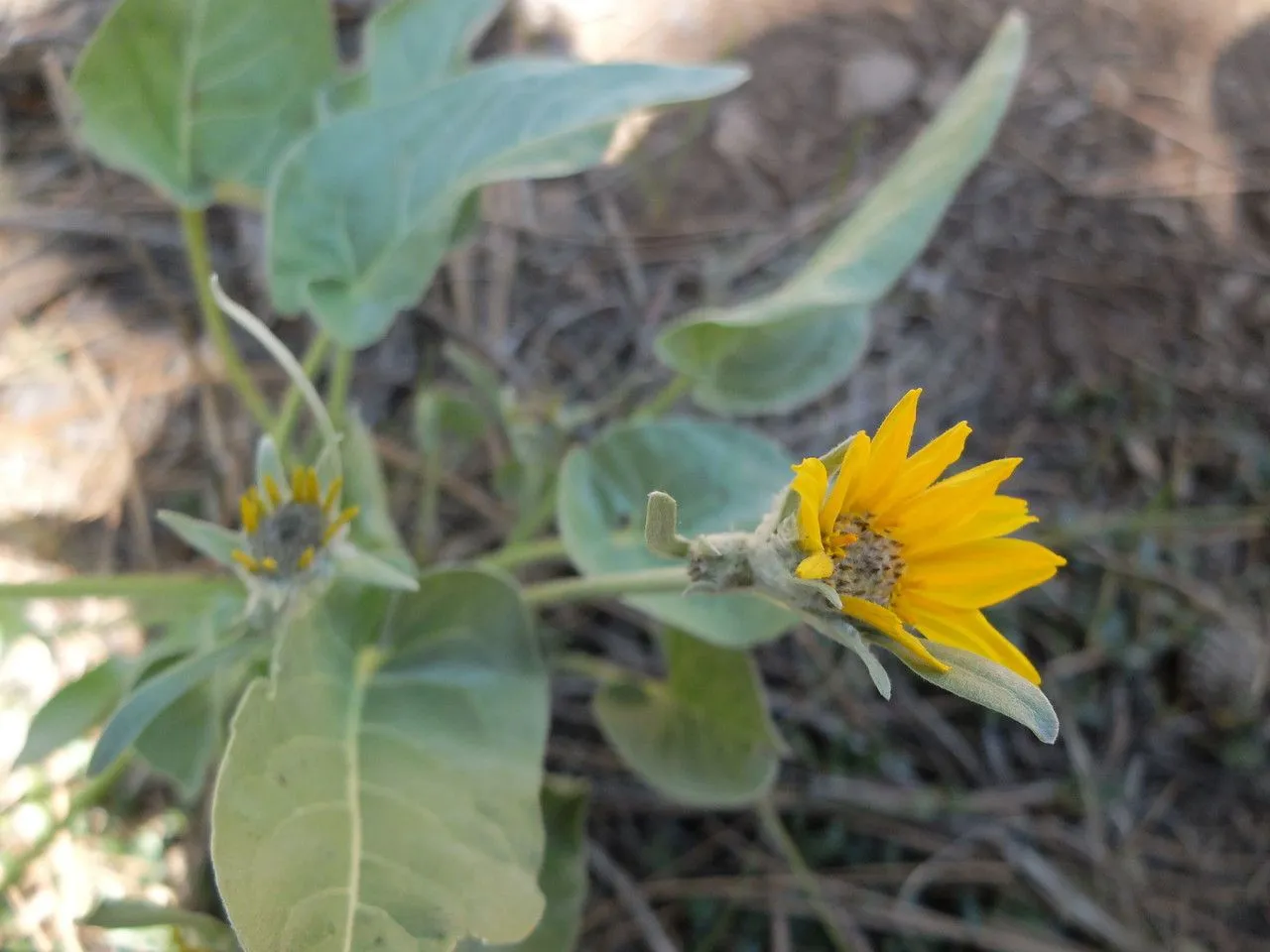
Author: (Pursh) Nutt.
Bibliography: Trans. Amer. Philos. Soc., ser. 2, 7: 350 (1840)
Year: 1840
Status: accepted
Rank: species
Genus: Balsamorhiza
Vegetable: False
Observations: W. Canada to W. & WC. U.S.A.
Arrowleaf balsamroot, scientifically known as Balsamorhiza sagittata, is a notable member of the Asteraceae family. First documented in the early 19th century in the “Transactions of the American Philosophical Society,” this resilient plant has since been observed across a broad geographical range, spanning from Western Canada to the western and west-central United States.
Characterized by its distinctive arrow-shaped leaves, which is a feature reflected in its common name, Arrowleaf balsamroot is renowned for its bright yellow, sunflower-like blooms. These blossoms provide a striking contrast to its silvery-green foliage, making it a visually appealing addition to the landscapes it inhabits.
This perennial herb thrives in a variety of environments, often found in open meadows, grasslands, and rocky areas. Its deep taproot system enables it to access water and nutrients from deep within the soil, contributing to its durability and ability to withstand drought conditions. As a result, Arrowleaf balsamroot plays a crucial ecological role by stabilizing soil and providing food resources for a range of wildlife, including bees, butterflies, and larger herbivores such as deer and elk.
Historically, Indigenous peoples highly valued Arrowleaf balsamroot for its medicinal and nutritional properties. They utilized various parts of the plant, from the roots to the seeds, in traditional remedies and as a food source. Today, it continues to be appreciated for its ecological benefits and its role in maintaining biodiversity within its native habitats.
In summary, Arrowleaf balsamroot (Balsamorhiza sagittata) is a remarkable plant known for its adaptability, ecological significance, and historical importance. Its presence across a wide swath of North America underscores its resilience and integral role within the ecosystems it inhabits.
Eng: arrowleaf balsamroot, arrow-leaved balsamroot
Swe: balsamrot
Fra: balsamorhize à feuilles sagittées
En: Arrowleaf balsamroot, Arrow-leaved balsamroot
Fr: Balsamorhize à feuilles sagittées
De: Pfeilblättrige Balsamwurzel
Sv: Balsamrot
Taken Jul 5, 2022 by eurmal (cc-by-sa)
Taken Apr 22, 2020 by Sara Kenney (cc-by-sa)
Taken May 12, 2021 by Devin Corbach (cc-by-sa)
Taken Apr 24, 2022 by allison finter (cc-by-sa)
Taken Jun 1, 2021 by Brittany Dobson (cc-by-sa)
Taken Apr 8, 2022 by Alison Salisbury (cc-by-sa)
Taken May 27, 2021 by Taylor Sample (cc-by-sa)
Taken Jun 9, 2022 by Marie-helene Clopath (cc-by-sa)
Taken Jun 3, 2019 by Jade jadestone (cc-by-sa)
Taken May 27, 2021 by Phil Stevens (cc-by-sa)
Taken Apr 29, 2021 by Bee A (cc-by-sa)
Taken May 1, 2021 by Matthew Arnold (cc-by-sa)
Taken Jun 1, 2021 by Brittany Dobson (cc-by-sa)
Taken May 27, 2021 by Taylor Sample (cc-by-sa)
Taken Apr 30, 2015 by EOL − faerthen (cc-by-nc)
Taken Sep 13, 2015 by EOL − chauncey (cc-by-nc)
Taken Apr 10, 2016 by EOL − milesproject (cc-by-nc)
Taken Apr 9, 2016 by EOL − g_phelan (cc-by-nc)
Taken Apr 29, 2021 by Ethan Greer (cc-by-sa)
Taken Apr 10, 2016 by EOL − g_phelan (cc-by-nc)
Growth form>: Multiple Stem
Growth habit>: Forb/herb
Growth rate>: Moderate
Ph maximum: 8.0
Ph minimum: 6.5
Family: Myrtaceae Author: (F.Muell.) K.D.Hill & L.A.S.Johnson Bibliography: Telopea 6: 402 (1995) Year: 1995 Status:…
Family: Rubiaceae Author: Pierre ex A.Froehner Bibliography: Notizbl. Bot. Gart. Berlin-Dahlem 1: 237 (1897) Year:…
Family: Sapindaceae Author: Koidz. Bibliography: J. Coll. Sci. Imp. Univ. Tokyo 32(1): 38 (1911) Year:…
Family: Asteraceae Author: A.Gray Bibliography: Pacif. Railr. Rep.: 107 (1857) Year: 1857 Status: accepted Rank:…
Family: Fabaceae Author: Medik. Bibliography: Vorles. Churpfälz. Phys.-Ökon. Ges. 2: 398 (1787) Year: 1787 Status:…
Family: Aspleniaceae Author: (Cav.) Alston Bibliography: Bull. Misc. Inform. Kew 1932: 309 (1932) Year: 1932…